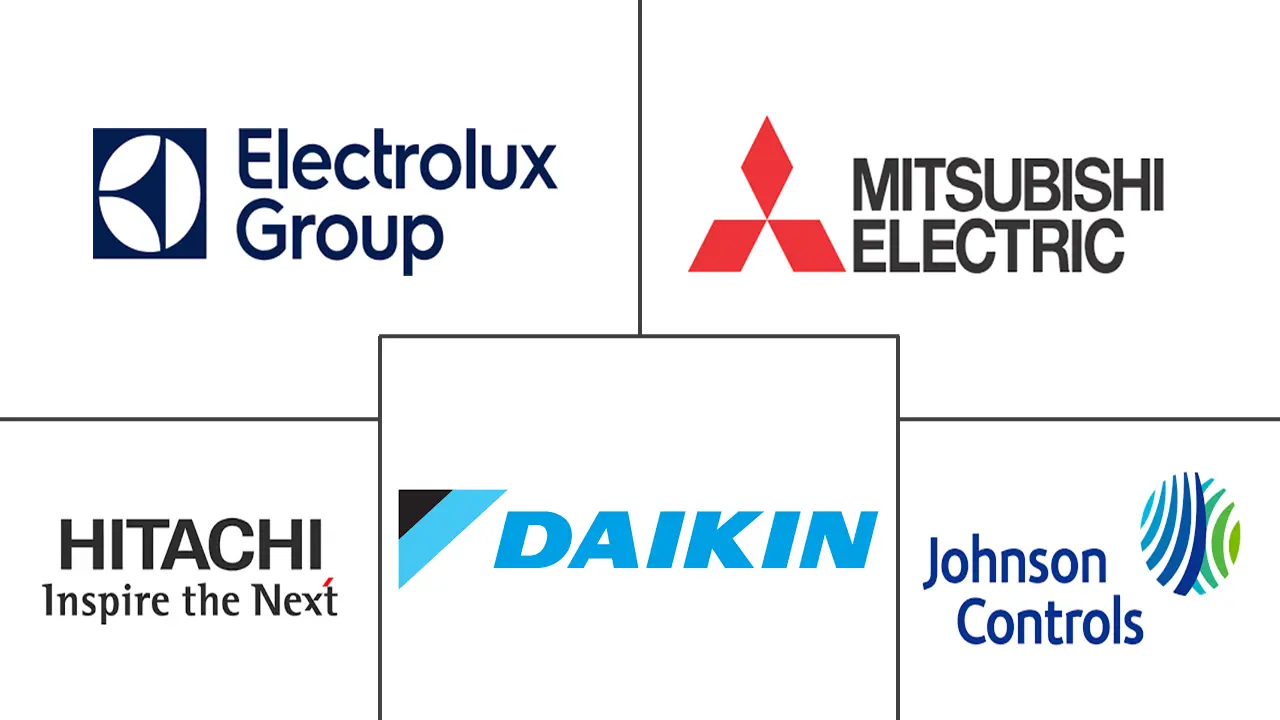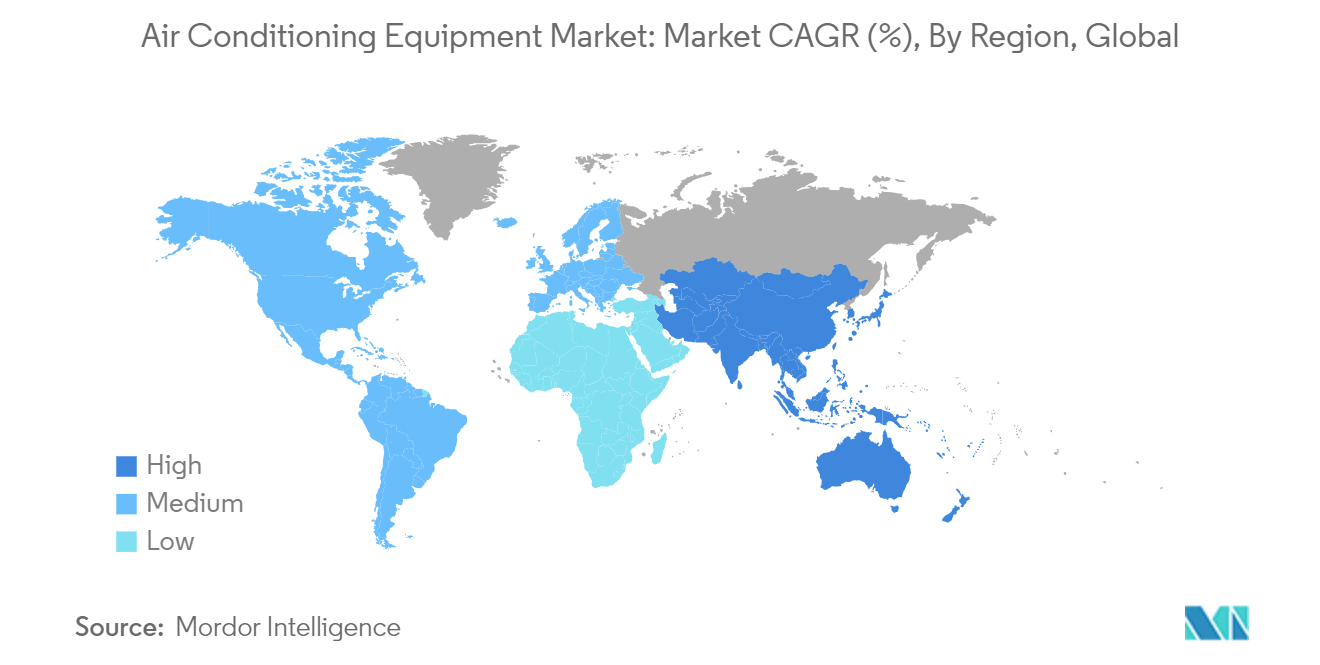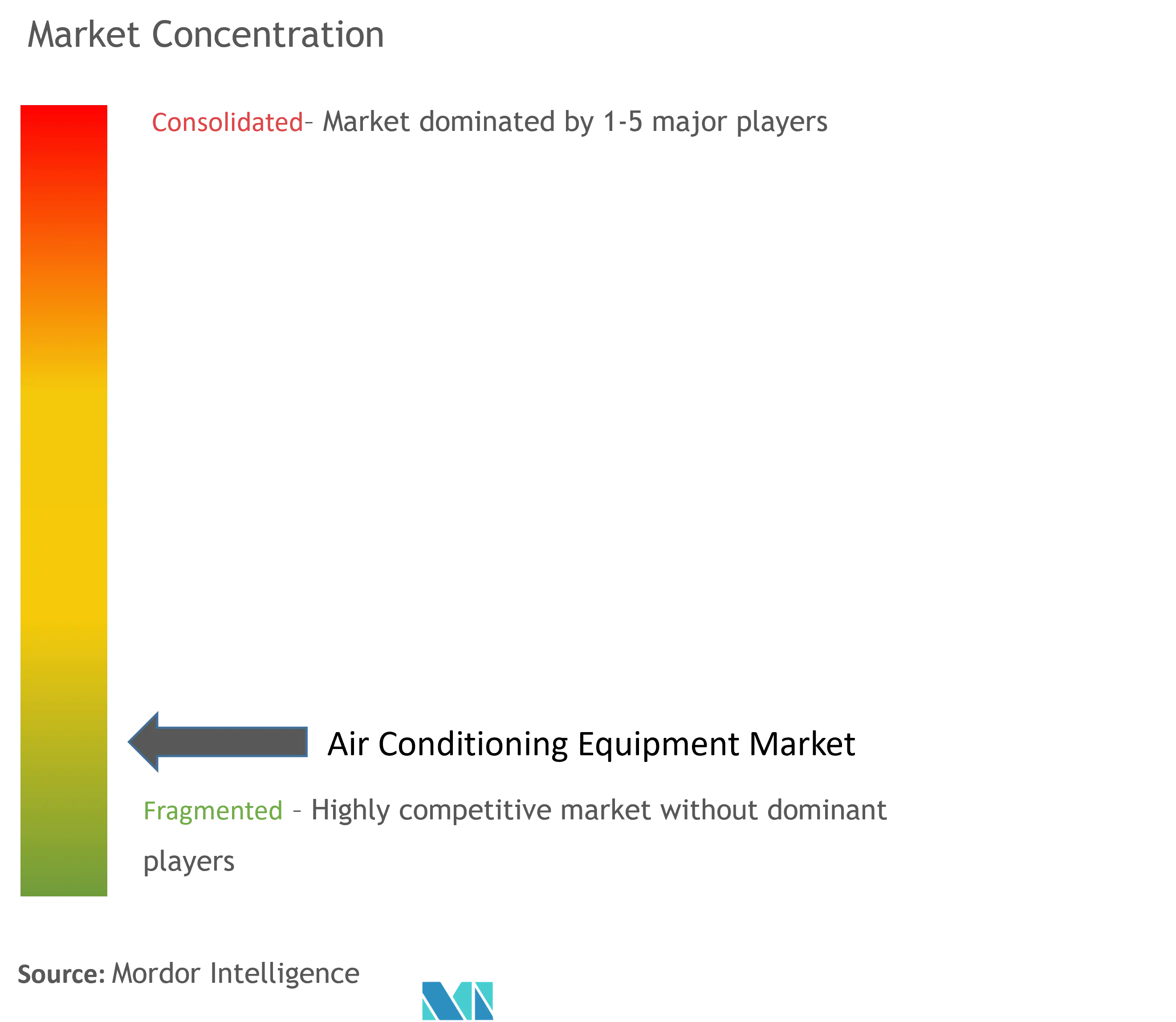Air Conditioning Equipment Market Size

| Study Period | 2019 - 2029 |
| Market Size (2024) | USD 119.36 Billion |
| Market Size (2029) | USD 154.65 Billion |
| CAGR (2024 - 2029) | 5.32 % |
| Fastest Growing Market | Asia-Pacific |
| Largest Market | North America |
Major Players
*Disclaimer: Major Players sorted in no particular order |
Air Conditioning Equipment Market Analysis
The Air Conditioning Equipment Market size is estimated at USD 119.36 billion in 2024, and is expected to reach USD 154.65 billion by 2029, growing at a CAGR of 5.32% during the forecast period (2024-2029).
An air conditioner extracts heat from a space and expells it outside, cooling indoor air. This cooled air is then circulated throughout a building via ventilation. Air conditioners are crucial in maintaining comfortable living temperatures as a pivotal HVAC system component.
Commonly referred to as "split systems," air conditioners consist of an outdoor unit, the condenser, and an indoor unit, the evaporator. Dehumidification occurs as warm indoor air moves over the cold evaporator, causing the air to condense and shed moisture, akin to how condensation forms on chilled glass. While split systems feature distinct indoor and outdoor units, there's also a "packaged" system where elements are integrated into a single outdoor unit.
- The growing construction sector is expected to boost the demand for AC equipment in the residential, commercial, and industrial sectors. The increasing construction spending and a surge in building permits across residential, commercial, and industrial sectors. Notably, the US construction sector is set for further growth, supported by significant federal investments in infrastructure. This positive trend isn't limited to public projects; private commercial construction is also gaining momentum.
- Rapid urbanization and economic expansion, especially in developing nations, are fueling a surge in residential and commercial construction, driving the demand for air conditioning systems. With increasing incomes, a growing number of households and businesses can now invest in and deploy air conditioning units.
- The escalation of global temperatures due to climate change has heightened the frequency and intensity of heatwaves worldwide. Consequently, there has been a surge in the demand for air conditioning systems. This demand is particularly pronounced in regions that historically had lower cooling needs.
- Air conditioning is significantly more prevalent in American households than in European ones. This trend is largely attributed to the climatic demands of specific US regions.
- For instance, the humid South and arid Southwest have historically necessitated cooling solutions. Highlighting the severity of the situation, the IEA has noted a rise in heat alerts in the Southwestern United States, underscoring the health risks. Moreover, central and southern US regions, known for their high humidity, exhibit a higher prevalence of air conditioning. Conversely, the Midwest, characterized by a mixed-humid climate and annual precipitation exceeding 20 inches, also sees a notable uptake in air conditioner usage.
- The air conditioning equipment market faced substantial disruptions due to the Russia-Ukraine conflict and an economic slowdown. Rising inflation and interest rates curbed consumer spending, dampening demand and stalling market growth. Additionally, the trade tensions between the United States and China exacerbated global supply chain disruptions, significantly affecting AC manufacturers in both nations.
Air Conditioning Equipment Market Trends
Split System is Expected to Register Significant Growth
- A split air conditioner consists of an outdoor unit and an indoor unit. In single-split systems, an interior and outdoor unit are connected by copper pipe. In multi-split systems, up to five indoor units of customer choice can be connected to one outside unit. The multi-split is appropriate for many rooms or large rooms and various climatic zones. The outdoor unit's small footprint and easy installation are major benefits.
- The firms are collaborating to provide energy-efficient and climatic-friendly split air conditioners. For instance, in its 2024 product lineup, LG Electronics introduced a series of air conditioners tailored for the Indian market. These units boast advanced technology, prioritizing energy efficiency and user comfort. LG's 2024 AC range has the Energy Manager, a technology that optimizes energy usage and guarantees top-notch cooling.
- Furthermore, introducing Midea's All Easy Series R290 units is a tipping point. Midea's portable R290 air conditioners have been available in Europe for some time. The most often used appliances for cooling spaces globally are split air conditioners mounted on an exterior wall. The R290 split air conditioners from Midea are expected to disrupt the European market and spark a change that will lower the continent's energy use and greenhouse gas emissions.
- Furthermore, in April 2024, Samsung Electronics Singapore unveiled its newest WindFree Air Conditioner series today. This launch marks an expansion of Samsung's lineup of home appliances aimed at enhancing homeowners' lifestyles. The series boasts features like comfort cooling, energy-saving capabilities, and a focus on connected living.
- In addition, according to LG Electronics, in 2023, it produced approximately 12.03 million air conditioners. These units were manufactured across facilities in South Korea, India, China, and Thailand.

North America is Expected to Hold Significant Market Share
- The air conditioning equipment market in North America is a robust and dynamic industry driven by factors such as rapid urbanization, technological advancements, climate change, and extreme weather.
- The rise in temperature in American cities and the sunbelt regions of Southwestern and southern America, caused by global warming and climate change, has led to greater use of different air conditioning systems in these areas. The necessity of cool air in specific US regions, like the humid South and the desert Southwest, has been a longstanding reality.
- The IEA has noted a rise in heat alerts in the Southwestern United States, underscoring the difficult conditions for human well-being. Additionally, the use of air conditioning is more common in the southern and central regions of the United States because of the higher levels of humidity found in those areas. Conversely, the Midwest encounters a mixed-humid climate with an annual rainfall exceeding 20 inches. These factors are expected to propel the demand for air conditioners in the country.
- Furthermore, according to the Department of Energy (DOE), a substantial 75% of US households own air conditioning units. These units consume roughly 6% of the nation's total electricity production, leading to an annual cost of approximately USD 29 billion for homeowners.
- As a result, approximately 117 million metric tons of carbon dioxide are emitted into the atmosphere annually. The growing initiatives to shift towards more energy-efficient air conditioners and implement other strategies to maintain comfortable indoor temperatures, as well as the goal of reducing energy usage for cooling purposes, are expected to enhance the market's potential.

Air Conditioning Equipment Industry Overview
The air conditioning equipment landscape is highly competitive, with several local and international players active. International participants operate in the country through partnerships with regional players. With the market expected to broaden and yield more opportunities, more players are expected to enter. The key players in the market studied include Mitsubishi Electric and Johnson Controls, among others. These major players have adopted various growth strategies, such as mergers and acquisitions, new product launches, expansions, joint ventures, partnerships, and others, to strengthen their position in this market.
- March 2024: Mitsubishi Electric Trane HVAC US LLC (METUS) announced the introduction of Premier Wall-mounted Indoor Units (MSZ-GS/MSY-GS). At the same time, Premier MSZ-GS Indoor Units are compatible with single-zone and multi-zone heat pump outdoor units, including single- and multi-zone Hyper-Heating INVERTER (H2i) units. The MSY-GS is a single-zone, cooling-only air conditioner for climates with unnecessary heating.
- February 2024: Daikin Industries Ltd enhanced its air conditioners by focusing on critical elements. This includes shifting to HFC-32, an R32 refrigerant with low global warming potential, emphasizing its eco-friendliness and energy efficiency. Additionally, Daikin has bolstered the fundamental performance of its air conditioning units. In a significant move, Daikin is set to launch the VRV 7 multi-air conditioner series for buildings in November 2024. This series boasts the industry's top energy efficiency and is pivotal in lessening environmental footprints and operational burdens.
Air Conditioning Equipment Market Leaders
-
Daikin Industries, Ltd.
-
Hitachi Ltd.
-
Johnson Controls
-
Electrolux AB Corporation
-
Mitsubishi Electric Corporation
*Disclaimer: Major Players sorted in no particular order

Air Conditioning Equipment Market News
- May 2024: Lennox and Samsung signed an agreement to market ductless ACs and heat pump products across the United States and Canada, including mini-split, multi-split, and VRF systems. This joint endeavor will operate under the Samsung Lennox HVAC North America banner.
- March 2024: Riello, a Carrier brand, launched a high-end residential range with the new RIELLO ELIXATM series of single-split inverter air conditioners. The RIELLO ELIXA wall-mounted air conditioners achieve energy class A+++ in cooling and heating, offering optimum user comfort and an environment-friendly home environment.
Air Conditioning Equipment Market Report - Table of Contents
1. INTRODUCTION
- 1.1 Study Assumption and Market Definition
- 1.2 Scope of the study
2. RESEARCH METHODOLOGY
3. EXECUTIVE SUMMARY
4. MARKET INSIGHTS
- 4.1 Market Overview
-
4.2 Industry Attractiveness - Porter's Five Forces Analysis
- 4.2.1 Bargaining Power of Suppliers
- 4.2.2 Bargaining Power of Buyers
- 4.2.3 Threat of New Entrants
- 4.2.4 Threat of Substitutes
- 4.2.5 Intensity of Competitive Rivalry
- 4.3 Industry Value Chain Analysis
- 4.4 Assessment of Macroeconomic Factors on the Market
5. MARKET DYNAMICS
-
5.1 Market Drivers
- 5.1.1 Replacement of Existing Equipment With Better Performing Ones
- 5.1.2 Supportive Government Regulations Including Incentives for Saving Energy Through Tax Credit Programs
-
5.2 Market Challenges
- 5.2.1 Dependence on Macro-economic Conditions
6. MARKET SEGMENTATION
-
6.1 By Type
- 6.1.1 Split System (Ducted and Ductless)
- 6.1.2 Variable Refrigerant Flow (VRF)
- 6.1.3 Air Handling Units
- 6.1.4 Chillers
- 6.1.5 Fan Coils
- 6.1.6 Indoor Packaged and Roof Tops
- 6.1.7 Other Types
-
6.2 By End-user Industry
- 6.2.1 Residential
- 6.2.2 Commercial
- 6.2.3 Industrial
-
6.3 By Geography***
- 6.3.1 North America
- 6.3.2 Asia
- 6.3.3 Australia and New Zealand
- 6.3.4 Europe
- 6.3.5 Latin America
- 6.3.6 Middle East and Africa
7. COMPETITIVE LANDSCAPE
-
7.1 Company Profiles
- 7.1.1 Daikin Industries Ltd
- 7.1.2 Hitachi Ltd
- 7.1.3 Electrolux AB Corporation
- 7.1.4 Mitsubishi Electric Corporation
- 7.1.5 Johnson Controls
- 7.1.6 Haier Group
- 7.1.7 Carrier Corporate
- 7.1.8 Panasonic Corporation
- 7.1.9 Alfa Laval AB
- 7.1.10 Lennox International Inc.
- *List Not Exhaustive
8. INVESTMENT ANALYSIS
9. FUTURE OF THE MARKET
** Subject To AvailablityAir Conditioning Equipment Industry Segmentation
Air conditioning equipment is designed to regulate temperatures and provide fresh air in rooms experiencing high temperatures and humidity, ensuring a comfortable indoor environment. The market study analyses the trends and opportunities for different types of air conditioning equipment, such as split systems, variable refrigerant flow, air handling units, chillers, fan coils, indoor packaged, and rooftops used in various end-user industry applications. Further, the study analyzes the impact of macroeconomic factors on the market.
The air conditioning equipment market is segmented by type (split system [ducted and ductless], variable refrigerant flow (VRF), air handling units, chillers, fan coils, indoor packaged and rooftops, and other types), end-user industry (residential, commercial, and industrial), and geography (North America, Asia-Pacific, Europe, Latin America, and Middle East and Africa). The report offers market forecasts and size in value (USD) for all the above segments.
| By Type | Split System (Ducted and Ductless) |
| Variable Refrigerant Flow (VRF) | |
| Air Handling Units | |
| Chillers | |
| Fan Coils | |
| Indoor Packaged and Roof Tops | |
| Other Types | |
| By End-user Industry | Residential |
| Commercial | |
| Industrial | |
| By Geography*** | North America |
| Asia | |
| Australia and New Zealand | |
| Europe | |
| Latin America | |
| Middle East and Africa |
Air Conditioning Equipment Market Research FAQs
How big is the Air Conditioning Equipment Market?
The Air Conditioning Equipment Market size is expected to reach USD 119.36 billion in 2024 and grow at a CAGR of 5.32% to reach USD 154.65 billion by 2029.
What is the current Air Conditioning Equipment Market size?
In 2024, the Air Conditioning Equipment Market size is expected to reach USD 119.36 billion.
Who are the key players in Air Conditioning Equipment Market?
Daikin Industries, Ltd., Hitachi Ltd., Johnson Controls, Electrolux AB Corporation and Mitsubishi Electric Corporation are the major companies operating in the Air Conditioning Equipment Market.
Which is the fastest growing region in Air Conditioning Equipment Market?
Asia-Pacific is estimated to grow at the highest CAGR over the forecast period (2024-2029).
Which region has the biggest share in Air Conditioning Equipment Market?
In 2024, the North America accounts for the largest market share in Air Conditioning Equipment Market.
What years does this Air Conditioning Equipment Market cover, and what was the market size in 2023?
In 2023, the Air Conditioning Equipment Market size was estimated at USD 113.01 billion. The report covers the Air Conditioning Equipment Market historical market size for years: 2019, 2020, 2021, 2022 and 2023. The report also forecasts the Air Conditioning Equipment Market size for years: 2024, 2025, 2026, 2027, 2028 and 2029.
Air Conditioning Equipment Industry Report
Statistics for the 2024 Air Conditioning Equipment market share, size and revenue growth rate, created by Mordor Intelligence™ Industry Reports. Air Conditioning Equipment analysis includes a market forecast outlook to 2029 and historical overview. Get a sample of this industry analysis as a free report PDF download.



